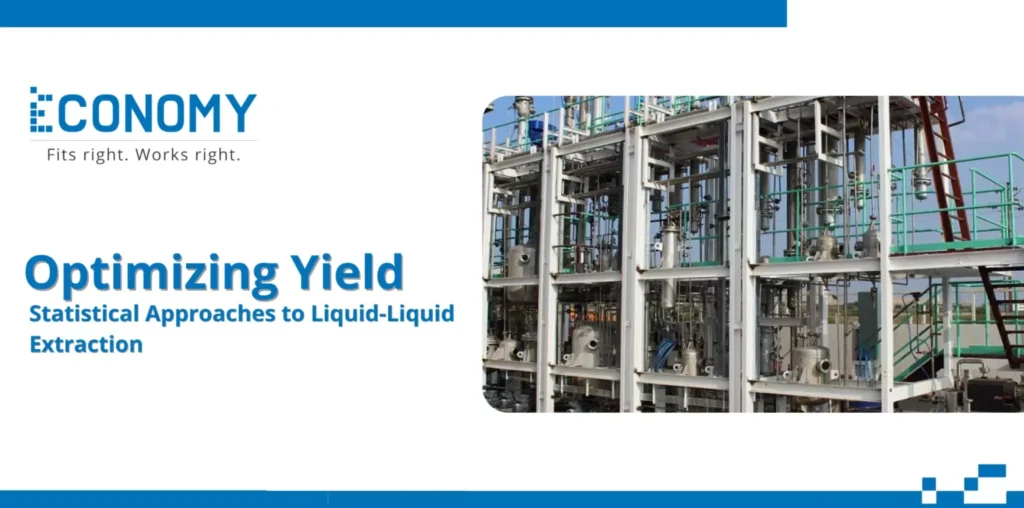How Liquid-Liquid Extractors Work
Liquid-liquid extraction (LLE) is a separation technique where a solute is transferred from one liquid phase to another, typically using immiscible solvents. This process is widely applied in industries like pharmaceuticals, petrochemicals, and environmental engineering to separate, purify, or concentrate valuable components. A typical liquid-liquid extractor involves two liquid phases: a feed solution containing the solute and an extracting solvent. The solvent is selected based on its high affinity for the solute, allowing it to pull the target compound out of the feed. These two immiscible liquids are then brought into close contact, usually within a mixing chamber or specialized extractor like a mixer-settler, centrifugal extractor, or packed column, facilitating mass transfer of the solute into the solvent phase.
After sufficient contact time, the mixture is allowed to settle, causing the two liquids to separate due to their density differences. The extract, now rich in the solute, is collected from the solvent layer, while the remaining feed phase is removed. Effective liquid-liquid extraction relies on maximizing the distribution coefficient, which is the ratio of solute concentration in the solvent phase to that in the feed phase, making careful selection of solvents essential. Since the process efficiency hinges on various operational factors, statistical methods can significantly improve extraction yields by systematically adjusting these parameters to their optimal levels.
Factors Affecting Yield in Liquid-Liquid Extraction
Several factors influence the yield and efficiency of liquid-liquid extraction, each impacting the process’s ability to achieve a high transfer of solute from the feed to the solvent phase. Solvent selection is one of the most critical factors, as it determines the solubility of the target compound in the extraction solvent. A solvent with a high affinity for the solute and low affinity for the feed impurities ensures higher selectivity and purity of the extracted compound. Temperature also plays a significant role, as it affects the solubility of the solute in both phases and the density difference between the two liquids, which in turn impacts the ease of separation.
Mixing intensity and contact time are additional factors that affect yield by enhancing mass transfer between the phases. Vigorous mixing increases the interfacial area, facilitating more efficient solute transfer into the solvent. However, excessive mixing can lead to emulsions, complicating phase separation. pH adjustments are sometimes required for compounds sensitive to ionization, as pH can impact solubility. In cases where solutes are pH-sensitive, adjusting the pH to make the solute more soluble in the solvent can greatly increase yield.
Phase ratio—the volume ratio of the solvent to the feed—is another key factor. A higher phase ratio typically increases the amount of solute extracted but requires more solvent, impacting process cost and solvent recovery needs. The number of extraction stages is also crucial; multi-stage extraction can significantly improve yield compared to single-stage extraction by incrementally reducing the solute concentration in the feed.
Statistical Approaches to Optimizing Yield
Statistical methods, including design of experiments (DOE), response surface methodology (RSM), and regression analysis, are invaluable tools for optimizing yield in liquid-liquid extraction. These techniques allow for a structured approach to systematically evaluate and fine-tune the variables impacting extraction efficiency. Design of Experiments (DOE) enables researchers to test multiple variables simultaneously, reducing the number of trials required to identify significant factors. By using factorial designs or fractional factorial designs, DOE determines how each factor, such as solvent type, temperature, and phase ratio, affects the extraction process individually and in combination with others.
Response Surface Methodology (RSM) is particularly useful for optimization. Once significant factors are identified, RSM helps determine the optimal levels of these variables, where yield reaches its peak. By plotting the response surface, researchers can visualize the effects of variable interactions and pinpoint the most effective operational conditions. For example, RSM can help determine the ideal phase ratio and mixing speed that maximize solute transfer while minimizing solvent usage. Regression analysis, another statistical tool, aids in creating predictive models that relate key variables to extraction yield. This approach allows operators to anticipate yield under different conditions, making it possible to predict outcomes and adjust parameters accordingly for improved efficiency.
Design and Operation of Liquid-Liquid Extractors for Statistical Approaches
When Design and Operation of Liquid-Liquid Extractors, it’s important to accommodate the optimal conditions identified through statistical analysis. Extractors like mixer-settlers, columns, and centrifugal extractors can be adjusted or designed to incorporate the ideal phase ratios, mixing intensity, and temperature control mechanisms. For instance, mixer-settler extractors allow precise control over mixing and settling times, which can be adjusted based on statistical findings to enhance yield. These extractors are particularly suitable for multi-stage extraction processes, where multiple contact points ensure maximum solute recovery.
In packed columns, packing material provides a large surface area for mass transfer, making it an ideal choice when the process requires a high interfacial area. Statistical methods can optimize packing height and type based on desired flow rates and phase separation needs. Centrifugal extractors, which apply centrifugal force to enhance phase separation, are effective for high-throughput, continuous processes. Statistical insights into optimal rotational speed, feed rates, and phase ratios help maximize efficiency while minimizing solvent loss.
Incorporating statistical insights during the design and operation of liquid-liquid extractors ensures a higher yield and lower operational costs. Operators can systematically monitor extraction performance, use predictive models to adjust process conditions dynamically, and achieve consistent, high-quality results. By aligning extractor design with statistical optimization, industries can achieve efficient, scalable liquid-liquid extraction processes that meet stringent quality and purity standards.




